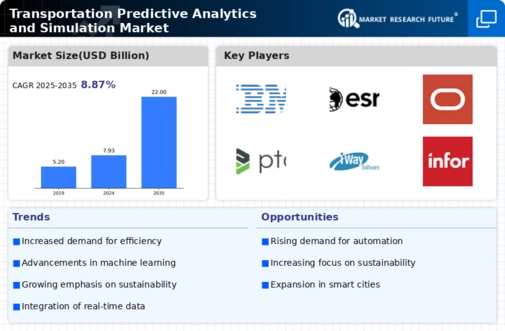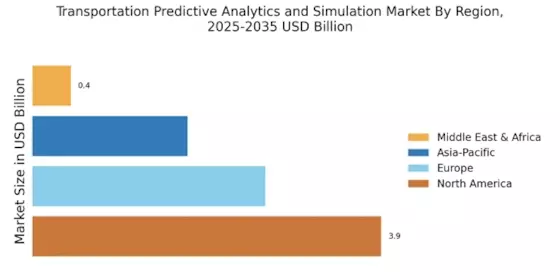Emergence of Autonomous Vehicles
The emergence of autonomous vehicles is reshaping the Transportation Predictive Analytics and Simulation Market. As the automotive industry advances towards automation, the demand for sophisticated predictive analytics tools is escalating. These tools are essential for simulating various driving scenarios and assessing the performance of autonomous systems under different conditions. The market for autonomous vehicle technology is expected to reach USD 60 billion by 2030, indicating a substantial opportunity for predictive analytics applications. This trend highlights the necessity for accurate modeling and simulation capabilities to ensure the safety and reliability of autonomous vehicles. Consequently, stakeholders are increasingly investing in predictive analytics solutions to support the development and deployment of these innovative transportation technologies.
Integration of Smart Technologies
The integration of smart technologies into transportation systems is a pivotal driver for the Transportation Predictive Analytics and Simulation Market. The advent of the Internet of Things (IoT) and connected vehicles has transformed how data is collected and analyzed. These technologies facilitate real-time monitoring and predictive modeling, allowing for proactive management of transportation networks. For instance, smart traffic signals can adapt to real-time traffic conditions, thereby reducing congestion and improving safety. The market for smart transportation solutions is expected to grow significantly, with estimates suggesting a valuation of USD 20 billion by 2025. This trend underscores the importance of predictive analytics in harnessing the potential of smart technologies to create more efficient and responsive transportation systems.
Government Initiatives and Funding
Government initiatives and funding play a crucial role in propelling the Transportation Predictive Analytics and Simulation Market. Many governments are recognizing the importance of data-driven decision-making in transportation planning and are allocating resources to develop predictive analytics capabilities. For example, various transportation departments are investing in simulation tools to model traffic scenarios and assess the impact of infrastructure changes. This trend is supported by federal funding programs aimed at enhancing transportation infrastructure and technology. As a result, the market is likely to witness increased investment, with projections indicating a growth rate of around 12% annually over the next five years. Such initiatives not only improve transportation efficiency but also contribute to economic development and sustainability goals.
Growing Focus on Safety and Risk Management
The growing focus on safety and risk management is a significant driver for the Transportation Predictive Analytics and Simulation Market. As transportation systems become more complex, the need for robust safety measures and risk assessment tools has intensified. Predictive analytics can identify potential hazards and simulate various scenarios to evaluate the effectiveness of safety interventions. This capability is particularly relevant in sectors such as aviation and public transit, where safety is paramount. The market for safety analytics in transportation is projected to grow, with estimates suggesting a value of USD 5 billion by 2025. This growth reflects the increasing recognition of the importance of data-driven safety strategies in mitigating risks and enhancing public confidence in transportation systems.
Rising Demand for Efficient Transportation Solutions
The Transportation Predictive Analytics and Simulation Market is experiencing a surge in demand for efficient transportation solutions. As urbanization accelerates, cities face increasing congestion and pollution challenges. Predictive analytics enables transportation planners to optimize traffic flow, reduce delays, and enhance overall system efficiency. According to recent estimates, the market for predictive analytics in transportation is projected to reach USD 10 billion by 2026, reflecting a compound annual growth rate of approximately 15%. This growth is driven by the need for real-time data analysis and simulation capabilities that can inform decision-making processes. Consequently, stakeholders are increasingly investing in advanced analytics tools to improve operational efficiency and enhance user experience.


















Leave a Comment